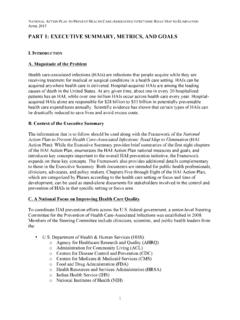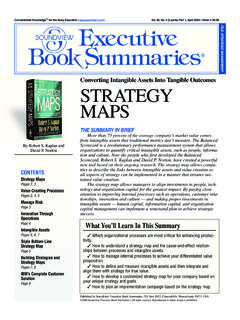Transcription of Software Assurance Maturity Model - opensamm.org
1 Software Assurance Maturity ModelA guide to building security into Software developmentVersion - work is licensed under the Creative Commons Attribution-Share Alike License. To view a copy of this license, visit or send a letter to Creative Commons, 171 Second Street, Suite 300, San Francisco, California, 94105, ArciniegasMatt BartoldusSebastien DeleersnyderJonathan CarterDarren ChalleyBrian ChessDinis CruzJustin DerryBart De WinJames McGovernMatteo MeucciJeff PayneGunnar PetersonJeff PiperAndy SteingrueblJohn StevenChad ThunbergColin WatsonJeff WilliamsAcknowledgementsThe Software Assurance Maturity Model (SAMM) was originally developed, designed, and written by Pravir Chandra an independent Software security consultant. Creation of the first draft was made possible through funding from Fortify Software , Inc. This document is currently maintained and updated through the OpenSAMM Project led by Pravir Chandra.
2 Since the initial re-lease of SAMM, this project has become part of the Open Web Application Security Project (OWASP). Thanks also go to many supporting organizations that are listed on back & reviewersThis work would not be possible without the support of many individual reviewers and experts that offered contributions and critical feedback. They are (in alphabetical order):For the Latest version and additionaL inFo, pLease see the project web site Open Web Application Security ProjectThe Open Web Application Security Project (OWASP) is a worldwide free and open community fo-cused on improving the security of application Software . Our mission is to make application security visible, so that people and organizations can make informed decisions about application security risks. Every- one is free to participate in OWASP and all of our materials are available under a free and open Software license.
3 The OWASP Foundation is a 501(c)3 not-for-profit charitable organization that en-sures the ongoing availability and support for our work. Visit OWASP online at is an OWASP ProjectsAMM / Software Assurance Maturity Model - SummaryBusiness FunctionsSecurity PracticesSAMM OverviewStrategy &MetricsEducation &GuidanceThreatAssessmentSecureArchitect ureSecurityRequirementsEnvironmentHarden ingOperationalEnablementVulnerabilityMan agementDesignReviewCodeReviewPolicy &ComplianceSecurityTestingGovernanceCons tructionDeploymentSoftwareDevelopmentThe Software Assurance Maturity Model (SAMM) is an open framework to help organizations for-mulate and implement a strategy for Software security that is tailored to the specific risks facing the organization. The resources provided by SAMM will aid in: Evaluating an organization s existing Software security practices Building a balanced Software security Assurance program in well-defined iterations Demonstrating concrete improvements to a security Assurance program Defining and measuring security-related activities throughout an organizationSAMM was defined with flexibility in mind such that it can be utilized by small, medium, and large orga-nizations using any style of development.
4 Additionally, this Model can be applied organization-wide, for a single line-of-business, or even for an individual project. Beyond these traits, SAMM was built on the following principles: An organization s behavior changes slowly over time - A successful Software security program should be specified in small iterations that deliver tangible Assurance gains while incrementally working toward long-term goals. There is no single recipe that works for all organizations - A Software security framework must be flexible and allow organizations to tailor their choices based on their risk tolerance and the way in which they build and use Software . Guidance related to security activities must be prescriptive - All the steps in building and assessing an Assurance program should be simple, well-defined, and measurable. This Model also provides roadmap templates for common types of foundation of the Model is built upon the core business functions of Software development with security practices tied to each (see diagram below).
5 The building blocks of the Model are the three ma-turity levels defined for each of the twelve security practices. These define a wide variety of activities in which an organization could engage to reduce security risks and increase Software Assurance . Additional details are included to measure successful activity performance, understand the associated Assurance benefits, estimate personnel and other an open project, SAMM content shall always remain vendor-neutral and freely available for all to / Software Assurance Maturity Model - summary .. 3 UnderstAnding the Model 6 Business Functions .. 8 Governance .. 10 Construction .. 12 Verification .. 14 Deployment .. 16 Applying the Model 18 Using the Maturity Levels .. 20 Conducting Assessments .. 21 Creating Scorecards .. 26 Building Assurance Programs .. 27 Independent Software Vendor .. 28 Online Service Provider.
6 29 Financial Services Organization .. 30 Government Organization .. 31the secUrity prActices 32 Strategy & metrics .. 34 Policy & Compliance .. 38 Education & Guidance .. 42 Threat Assessment .. 46 Security Requirements .. 50 Secure Architecture .. 54 Design Analysis .. 58 Code Review .. 62 Security Testing .. 66 Vulnerability Management .. 70 Environment Hardening .. 74 Operational Enablement .. 78cAse stUdies 82 VirtualWare .. 84sAMM / Software Assurance Maturity Model - existing Software Assurance practices 3 executive summary 8-9 Business Functions 10-11 Governance 12-13 Construction 14-15 Verification 16-17 Deployment 21-25 Conducting Assessments 26 Creating Scorecards 20 Using the Maturity Levels 34-37 Strategy & metrics 38-41 Policy & Compliance 42-45 Education & Guidance 46-49 Threat Assessment 50-53 Security Requirements 54-57 Secure Architecture 58-61 Design Review 62-65 Code Review 66-69 Security Testing 70-73 Vulnerability Management 74-77 Environment Hardening 78-81 Operational Enablement 27-31 Building Assurance Programs 84-95 VirtualWarei woUld like a strategic roadmap for an organization 3 executive summary 8-9 Business Functions 10-11 Governance 12-13 Construction 14-15 Verification 16-17 Deployment 20 Using the Maturity Levels 27-31
7 Building Assurance Programs 21-25 Conducting Assessments 26 Creating Scorecards 84-95 VirtualWare 34-37 Strategy & metrics 38-41 Policy & Compliance 42-45 Education & Guidance 46-49 Threat Assessment 50-53 Security Requirements 54-57 Secure Architecture 58-61 Design Review 62-65 Code Review 66-69 Security Testing 70-73 Vulnerability Management 74-77 Environment Hardening 78-81 Operational EnablementImplement or perform security activities 3 executive summary 8-9 Business Functions 10-11 Governance 12-13 Construction 14-15 Verification 16-17 Deployment 20 Using the Maturity Levels 34-37 Strategy & metrics 38-41 Policy & Compliance 42-45 Education & Guidance 46-49 Threat Assessment 50-53 Security Requirements 54-57 Secure Architecture 58-61 Design Review 62-65 Code Review 66-69 Security Testing 70-73 Vulnerability Management 74-77 Environment Hardening 78-81 Operational Enablement 21-25 Conducting Assessments 26 Creating Scorecards27-31 Building Assurance Programs 84-95 VirtualWare r ead skimUnderstanding the ModelA view of the big pictureSAMM is built upon a collection of Security Practices that are tied back into the core Business Functions involved in Software development.
8 This section introduces those Business Functions and the corresponding Security Practices for each. After covering the high-level framework, the Maturity Levels for each Security Practice are also discussed briefly in order to paint a picture of how each can be iteratively improved over / understAnding the Model - the highest level, SAMM defines four critical Business Functions. Each Business Function (list-ed below) is a category of activities related to the nuts-and-bolts of Software development, or stated another way, any organization involved with Software development must fulfill each of these Business Functions to some each Business Function, SAMM defines three Security Practices. Each Security Practice (list-ed opposite) is an area of security-related activities that build Assurance for the related Business Func-tion. So overall, there are twelve Security Practices that are the independent silos for improvement that map underneath the Business Functions of Software each Security Practice, SAMM defines three Maturity Levels as Objectives.
9 Each Level within a Security Practice is characterized by a successively more sophisticated Objective defined by specific activities and more stringent success metrics than the previous level. Additionally, each Security Practice can be improved independently, though related activities can lead to is centered on the processes and activities related to how an organization manages overall Software development activities. More specifically, this includes concerns that cross-cut groups involved in development as well as business processes that are established at the organization concerns the processes and activities related to how an organization defines goals and creates Software within development projects. In general, this will include product management, re-quirements gathering, high-level architecture specification, detailed design, and is focused on the processes and activities related to how an organization checks and tests artifacts produced throughout Software development.
10 This typically includes quality Assurance work such as testing, but it can also include other review and evaluation entails the processes and activities related to how an organization manages release of Software that has been created. This can involve shipping products to end users, deploying products to internal or external hosts, and normal operations of Software in the runtime on page on page on page on page 16sAMM / understAnding the Model - Assessment involves accu-rately identifying and characterizing poten-tial attacks upon an organization s Software in order to better understand the risks and facilitate risk Requirements involves promoting the inclusion of security-related requirements during the Software develop-ment process in order to specify correct functionality from Architecture involves bol-stering the design process with activities to promote secure-by-default designs and control over technologies and frameworks upon which Software is Review involves inspection of the artifacts created from the design pro-cess to ensure provision of adequate se-curity mechanisms and adherence to an organization s expectations for Review involves assessment of







